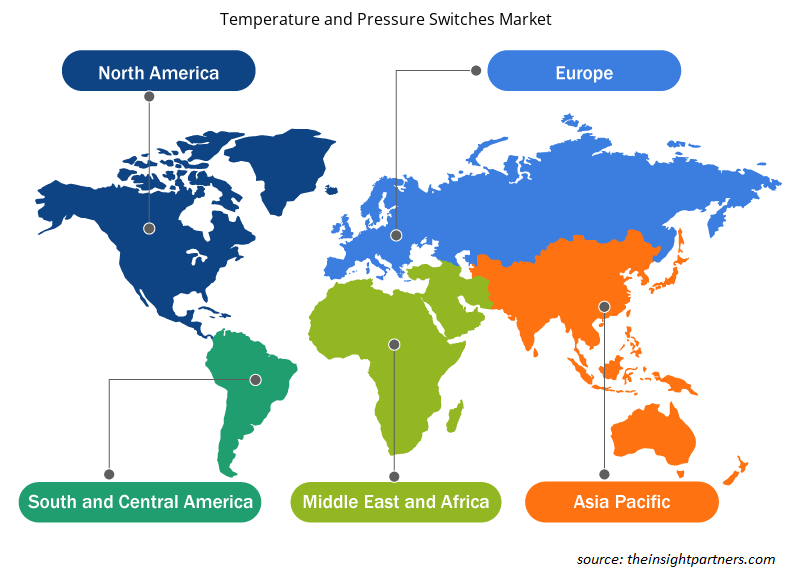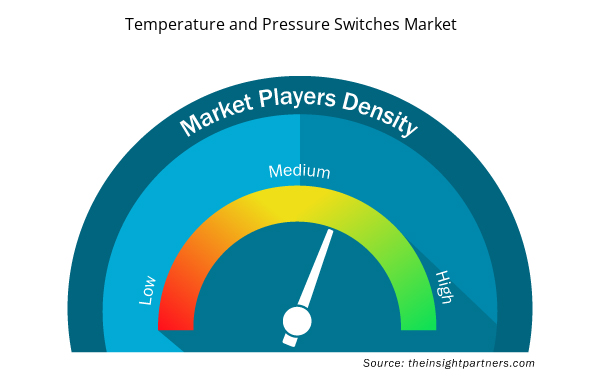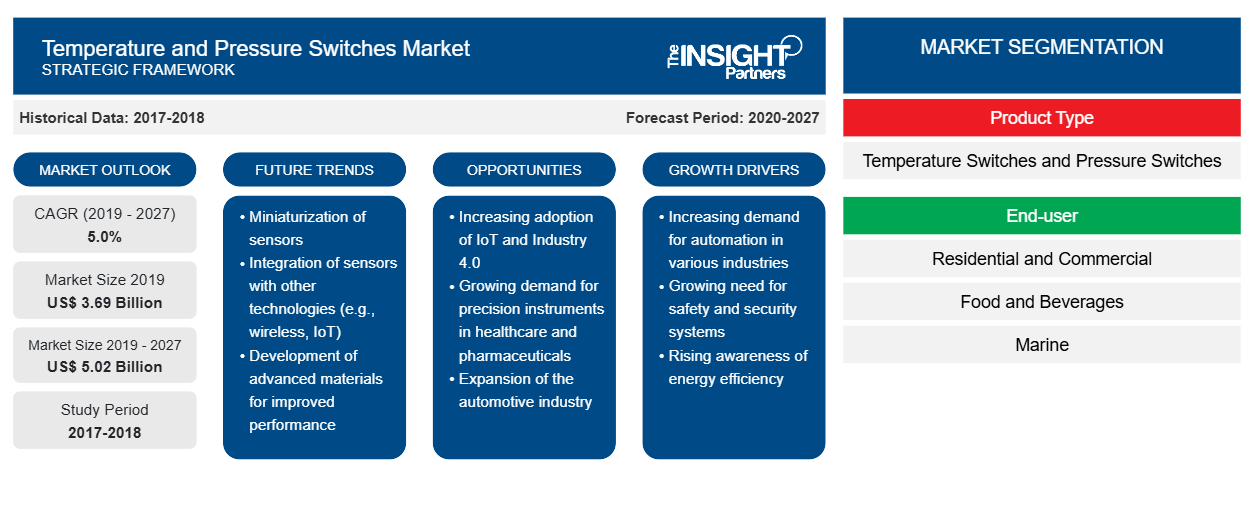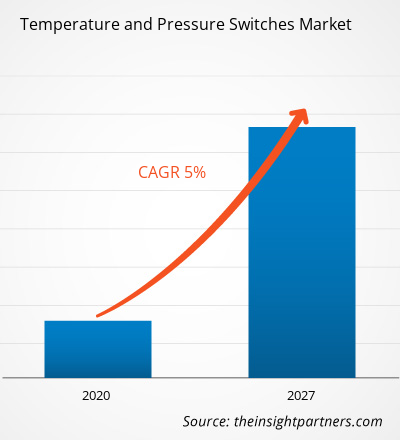Der Markt für Temperatur- und Druckschalter wurde im Jahr 2019 auf 3.689,62 Millionen US-Dollar geschätzt und soll bis 2027 einen Wert von 5.023,18 Millionen US-Dollar erreichen; von 2020 bis 2027 dürfte er mit einer durchschnittlichen jährlichen Wachstumsrate von 5,0 % wachsen.
Die Einführung automatisierter Technologien für Fertigungsprozesse hat im Laufe der Jahre stark zugenommen, insbesondere in Industrieländern. Aus diesem Grund konzentrieren sich diese Länder stark auf die Einführung intelligenter Fabriken. Die Länder mit einer erheblich höheren Anzahl an Fertigungsanlagen – darunter die USA, Kanada, China, Großbritannien, Japan, Deutschland und Frankreich – suchen branchenübergreifend kontinuierlich nach automatisierten Technologien für Fertigungsanlagen. Die Nachfrage nach hochwertigen Automobilen steigt weltweit, was zu einer erhöhten Fahrzeugproduktion führt, vor allem in den Industrieregionen wie Nordamerika und Europa. Die Nachfrage nach Nutzfahrzeugen und Personenkraftwagen steigt vor allem in Entwicklungsländern. Laut der International Tin Association Ltd. beispielsweise wurden in China im Jahr 2014 24 Millionen Fahrzeuge produziert, und diese Zahl soll bis 2030 bzw. 2050 auf 364 bzw. 607 Millionen steigen. Die wachsenden Investitionen in die Automobilindustrie haben daher die Nachfrage nach Temperatur- und Druckschaltern angekurbelt. Darüber hinaus ermöglicht die Entstehung des industriellen Internets der Dinge ( IIoT ) und intelligenter Fabriken den Endnutzern, technologisch fortschrittliche Lösungen für ihre Produktionsanlagen zu beschaffen, die ihnen letztlich durch höhere Produktivität höhere Gewinne bringen. Die Implementierung von IIoT nimmt branchenübergreifend weltweit rasant zu. Dies führt den Wachstumspfad des Marktes für Temperatur- und Druckschalter an.
Passen Sie diesen Bericht Ihren Anforderungen an
Sie erhalten kostenlos individuelle Anpassungen an jedem Bericht, einschließlich Teilen dieses Berichts oder einer Analyse auf Länderebene, eines Excel-Datenpakets sowie tolle Angebote und Rabatte für Start-ups und Universitäten.
- Holen Sie sich die wichtigsten Markttrends aus diesem Bericht.Dieses KOSTENLOSE Beispiel umfasst eine Datenanalyse von Markttrends bis hin zu Schätzungen und Prognosen.
Auswirkungen der COVID-19-Pandemie auf den Markt für Temperatur- und Druckschalter
Durch den plötzlichen Ausbruch der COVID-19-Pandemie ist die Wirtschaft des Landes eingebrochen, was sich negativ auf mehrere Branchen wie Marine, Militär und Verteidigung auswirkte, was sich negativ auf den Markt für Temperatur- und Druckschalter ausgewirkt hat. Daher werden sich die anhaltende COVID-19-Krise und die kritische Situation in der Welt in den nächsten Quartalen negativ auf das Marktwachstum für Temperatur- und Druckschalter in der Region Nordamerika auswirken.
Markteinblicke – Markt für Temperatur- und Druckschalter
Steigende Automobilproduktion und wachsende Nachfrage nach Temperatur- und Druckschaltern in der Automobilindustrie
Die Nachfrage nach Nutzfahrzeugen und Personenkraftwagen steigt, vor allem in Entwicklungsländern. Laut der International Tin Association Ltd. beispielsweise wurden in China im Jahr 2014 24 Millionen Fahrzeuge produziert. Bis 2030 und 2050 dürfte diese Zahl auf 364 bzw. 607 Millionen steigen. Die steigenden Investitionen in die Automobilindustrie haben also die Nachfrage nach Temperatur- und Druckschaltern angeheizt. Laut dem Center for Automotive Research, einer gemeinnützigen Organisation, haben Automobilhersteller wie FCA, GM, Ford, Hyundai, Nissan, Volkswagen und Toyota im Jahr 2018 4,8 Milliarden US-Dollar in die Automobilindustrie investiert. Darüber hinaus sind in Europa die Investitionen in Forschung und Entwicklung (F&E) der Automobilindustrie um 6,7 % auf 67,09 Milliarden US-Dollar jährlich gestiegen. Die Temperaturschalter werden robust in Kühlerlüfter, Warnleuchte und Kühlmittelüberwachungssystem integriert, um die Temperatur der Fahrzeugkomponenten ständig zu überwachen.
Endbenutzerbasierte Erkenntnisse
Basierend auf dem Endverbraucher ist der Markt für Temperatur- und Druckschalter in Wohn- und Gewerbebereich, Lebensmittel und Getränke, Schifffahrt, Automobil, Luft- und Raumfahrt und Verteidigung, Chemie, Öl und Gas und andere unterteilt. Das Automobilsegment hatte 2019 einen größeren Marktanteil.
Die Akteure auf dem Markt für Temperatur- und Druckschalter konzentrieren sich hauptsächlich auf die Entwicklung fortschrittlicher und effizienter Produkte.
- ABB Ltd. eröffnet ein Vertriebszentrum in Phoenix im US-Bundesstaat Arizona, das dem Unternehmen als Vertriebszentrum für die Westküste dienen wird.
- Eaton Corp. investiert 100 Millionen US-Dollar in die Erweiterung seiner Elektroproduktions- und Vertriebszentren in Nordamerika für gewerbliche und private Kunden.
Regionale Einblicke in den Markt für Temperatur- und Druckschalter
Die regionalen Trends und Faktoren, die den Markt für Temperatur- und Druckschalter im Prognosezeitraum beeinflussen, wurden von den Analysten von Insight Partners ausführlich erläutert. In diesem Abschnitt werden auch die Marktsegmente und die Geografie für Temperatur- und Druckschalter in Nordamerika, Europa, im asiatisch-pazifischen Raum, im Nahen Osten und Afrika sowie in Süd- und Mittelamerika erörtert.

- Erhalten Sie regionale Daten zum Markt für Temperatur- und Druckschalter
Umfang des Marktberichts zu Temperatur- und Druckschaltern
| Berichtsattribut | Details |
|---|---|
| Marktgröße im Jahr 2019 | 3,69 Milliarden US-Dollar |
| Marktgröße bis 2027 | 5,02 Milliarden US-Dollar |
| Globale CAGR (2019 - 2027) | 5,0 % |
| Historische Daten | 2017-2018 |
| Prognosezeitraum | 2020–2027 |
| Abgedeckte Segmente | Nach Produkttyp
|
| Abgedeckte Regionen und Länder | Nordamerika
|
| Marktführer und wichtige Unternehmensprofile |
|
Marktteilnehmerdichte für Temperatur- und Druckschalter: Auswirkungen auf die Geschäftsdynamik verstehen
Der Markt für Temperatur- und Druckschalter wächst rasant, angetrieben durch die steigende Nachfrage der Endnutzer aufgrund von Faktoren wie sich entwickelnden Verbraucherpräferenzen, technologischen Fortschritten und einem größeren Bewusstsein für die Vorteile des Produkts. Mit steigender Nachfrage erweitern Unternehmen ihr Angebot, entwickeln Innovationen, um die Bedürfnisse der Verbraucher zu erfüllen, und nutzen neue Trends, was das Marktwachstum weiter ankurbelt.
Die Marktteilnehmerdichte bezieht sich auf die Verteilung der Firmen oder Unternehmen, die in einem bestimmten Markt oder einer bestimmten Branche tätig sind. Sie gibt an, wie viele Wettbewerber (Marktteilnehmer) in einem bestimmten Marktraum im Verhältnis zu seiner Größe oder seinem gesamten Marktwert präsent sind.
Die wichtigsten auf dem Markt für Temperatur- und Druckschalter tätigen Unternehmen sind:
- ABB Ltd.
- Baumer Holding AG
- Beck GmbH Druckkontrolltechnik
- Danfoss A/S
- Eaton Corporation plc.
Haftungsausschluss : Die oben aufgeführten Unternehmen sind nicht in einer bestimmten Reihenfolge aufgeführt.

- Erhalten Sie einen Überblick über die wichtigsten Akteure auf dem Markt für Temperatur- und Druckschalter
Der Markt für Temperatur- und Druckschalter wurde wie folgt segmentiert:
Markt für Temperatur- und Druckschalter – nach Produkttyp
- Temperaturschalter
- Druckschalter
Markt für Temperatur- und Druckschalter – nach Endbenutzer
- Wohn- und Gewerbebereich
- Essen und Trinken
- Marine
- Automobilindustrie
- Luft- und Raumfahrt und Verteidigung
- Chemikalien
- Öl und Gas
- Sonstiges
Markt für Temperatur- und Druckschalter – nach Geografie
- Nordamerika
- UNS
- Kanada
- Mexiko
- Europa
- Deutschland
- Frankreich
- Italien
- Vereinigtes Königreich
- Russland
- Restliches Europa
- Asien-Pazifik (APAC)
- Australien
- China
- Indien
- Japan
- Südkorea
- Restlicher Asien-Pazifik-Raum
- Naher Osten, Afrika (MEA)
- Südafrika
- Saudi-Arabien
- Vereinigte Arabische Emirate
- Rest von MEA
- Südamerika
- Brasilien
- Argentinien
- Rest von SAM
Markt für Temperatur- und Druckschalter – Firmenprofile
- ABB Ltd
- Baumer Holding AG
- Beck GmbH Druckkontrolltechnik
- Danfoss A/S
- Eaton Corporation plc
- Honeywell International Inc.
- Parker Hannifin Corporation
- Schneider Electric
- SMC Corporation
- WIKA Alexander Wiegand SE & Co. KG
- Historische Analyse (2 Jahre), Basisjahr, Prognose (7 Jahre) mit CAGR
- PEST- und SWOT-Analyse
- Marktgröße Wert/Volumen – Global, Regional, Land
- Branche und Wettbewerbsumfeld
- Excel-Datensatz


- Analog-to-Digital Converter Market
- Sterilization Services Market
- MEMS Foundry Market
- Authentication and Brand Protection Market
- Electronic Signature Software Market
- Aircraft MRO Market
- Rare Neurological Disease Treatment Market
- Drain Cleaning Equipment Market
- Travel Vaccines Market
- Micro-Surgical Robot Market

Report Coverage
Revenue forecast, Company Analysis, Industry landscape, Growth factors, and Trends

Segment Covered
This text is related
to segments covered.

Regional Scope
North America, Europe, Asia Pacific, Middle East & Africa, South & Central America

Country Scope
This text is related
to country scope.
Häufig gestellte Fragen
The temperature & pressure switches market is led by automotive segment with highest share and is expected to dominate in the forecast period. The automotive industry is set to bolster over the next decade due to an enormous rise in demand for vehicles. The vehicle coolant monitoring system, radiator fan, and warning lamp integrates temperature switches into it. Similarly, the brake light, exhaust gas recirculation, emission control system, and HVAC system in the vehicle integrates pressure switches for proper functioning. This is expected to double the number of production units, which is further expected to create ample business growth opportunities for the temperature and pressure switches market players.
The temperature & pressure switches permit the end-user to carry out smooth operations, are used with flammable material, and in hazardous locations, thus increases its application in numerous end-use industries. The growing demand for temperature & pressure switches is anticipated to rise in the forecast period, owing to the increasing number of end-use industries. Moreover, consumers are demanding technologically advanced products that are capable of enhanced monitoring capabilities, drive the adoption of the temperature and pressure switches.
Mounting requirement for temperature sensors is expected to boost the demand for temperature & pressure switches during the forecast period. There is an increase in adoption of temperature switches in the manufacturing of heating systems, burners, boilers, air heaters, and circulation pumps. Moreover, temperature switches are comprehensively being used across general-purpose applications. Increasing demand from pharmaceuticals, automotive, and food & beverages industries is one of the significant factors boosting the temperature & pressure switches market during the forecast period. Rising complexity of modern industrial machinery continues to drive innovations across the temperature & pressure switches market. Several market players are entering the competitive market for pressure switches, mainly in the Asia Pacific region's emerging economies. Manufacturers are progressively investing resources in research and development and enhancing their product range with the evolving industrial demands. The pressure switches are robustly used for multiple applications across different sectors, such as marine, aerospace & defense, automotive, food & beverages, and oil & gas. The market players are expected to fulfill the regulatory standards and manufacture the temperature & pressure switches to gain approval from the dedicated regulatory body. This anticipated to offer ample growth opportunities for the global temperature & pressure switches market players.
Trends and growth analysis reports related to Electronics and Semiconductor : READ MORE..
The Insight Partners performs research in 4 major stages: Data Collection & Secondary Research, Primary Research, Data Analysis and Data Triangulation & Final Review.
- Data Collection and Secondary Research:
As a market research and consulting firm operating from a decade, we have published and advised several client across the globe. First step for any study will start with an assessment of currently available data and insights from existing reports. Further, historical and current market information is collected from Investor Presentations, Annual Reports, SEC Filings, etc., and other information related to company’s performance and market positioning are gathered from Paid Databases (Factiva, Hoovers, and Reuters) and various other publications available in public domain.
Several associations trade associates, technical forums, institutes, societies and organization are accessed to gain technical as well as market related insights through their publications such as research papers, blogs and press releases related to the studies are referred to get cues about the market. Further, white papers, journals, magazines, and other news articles published in last 3 years are scrutinized and analyzed to understand the current market trends.
- Primary Research:
The primarily interview analysis comprise of data obtained from industry participants interview and answers to survey questions gathered by in-house primary team.
For primary research, interviews are conducted with industry experts/CEOs/Marketing Managers/VPs/Subject Matter Experts from both demand and supply side to get a 360-degree view of the market. The primary team conducts several interviews based on the complexity of the markets to understand the various market trends and dynamics which makes research more credible and precise.
A typical research interview fulfils the following functions:
- Provides first-hand information on the market size, market trends, growth trends, competitive landscape, and outlook
- Validates and strengthens in-house secondary research findings
- Develops the analysis team’s expertise and market understanding
Primary research involves email interactions and telephone interviews for each market, category, segment, and sub-segment across geographies. The participants who typically take part in such a process include, but are not limited to:
- Industry participants: VPs, business development managers, market intelligence managers and national sales managers
- Outside experts: Valuation experts, research analysts and key opinion leaders specializing in the electronics and semiconductor industry.
Below is the breakup of our primary respondents by company, designation, and region:

Once we receive the confirmation from primary research sources or primary respondents, we finalize the base year market estimation and forecast the data as per the macroeconomic and microeconomic factors assessed during data collection.
- Data Analysis:
Once data is validated through both secondary as well as primary respondents, we finalize the market estimations by hypothesis formulation and factor analysis at regional and country level.
- Macro-Economic Factor Analysis:
We analyse macroeconomic indicators such the gross domestic product (GDP), increase in the demand for goods and services across industries, technological advancement, regional economic growth, governmental policies, the influence of COVID-19, PEST analysis, and other aspects. This analysis aids in setting benchmarks for various nations/regions and approximating market splits. Additionally, the general trend of the aforementioned components aid in determining the market's development possibilities.
- Country Level Data:
Various factors that are especially aligned to the country are taken into account to determine the market size for a certain area and country, including the presence of vendors, such as headquarters and offices, the country's GDP, demand patterns, and industry growth. To comprehend the market dynamics for the nation, a number of growth variables, inhibitors, application areas, and current market trends are researched. The aforementioned elements aid in determining the country's overall market's growth potential.
- Company Profile:
The “Table of Contents” is formulated by listing and analyzing more than 25 - 30 companies operating in the market ecosystem across geographies. However, we profile only 10 companies as a standard practice in our syndicate reports. These 10 companies comprise leading, emerging, and regional players. Nonetheless, our analysis is not restricted to the 10 listed companies, we also analyze other companies present in the market to develop a holistic view and understand the prevailing trends. The “Company Profiles” section in the report covers key facts, business description, products & services, financial information, SWOT analysis, and key developments. The financial information presented is extracted from the annual reports and official documents of the publicly listed companies. Upon collecting the information for the sections of respective companies, we verify them via various primary sources and then compile the data in respective company profiles. The company level information helps us in deriving the base number as well as in forecasting the market size.
- Developing Base Number:
Aggregation of sales statistics (2020-2022) and macro-economic factor, and other secondary and primary research insights are utilized to arrive at base number and related market shares for 2022. The data gaps are identified in this step and relevant market data is analyzed, collected from paid primary interviews or databases. On finalizing the base year market size, forecasts are developed on the basis of macro-economic, industry and market growth factors and company level analysis.
- Data Triangulation and Final Review:
The market findings and base year market size calculations are validated from supply as well as demand side. Demand side validations are based on macro-economic factor analysis and benchmarks for respective regions and countries. In case of supply side validations, revenues of major companies are estimated (in case not available) based on industry benchmark, approximate number of employees, product portfolio, and primary interviews revenues are gathered. Further revenue from target product/service segment is assessed to avoid overshooting of market statistics. In case of heavy deviations between supply and demand side values, all thes steps are repeated to achieve synchronization.
We follow an iterative model, wherein we share our research findings with Subject Matter Experts (SME’s) and Key Opinion Leaders (KOLs) until consensus view of the market is not formulated – this model negates any drastic deviation in the opinions of experts. Only validated and universally acceptable research findings are quoted in our reports.
We have important check points that we use to validate our research findings – which we call – data triangulation, where we validate the information, we generate from secondary sources with primary interviews and then we re-validate with our internal data bases and Subject matter experts. This comprehensive model enables us to deliver high quality, reliable data in shortest possible time.


 Holen Sie sich ein kostenloses Muster für diesen Bericht
Holen Sie sich ein kostenloses Muster für diesen Bericht